
Amateur telescope making
Encyclopedia
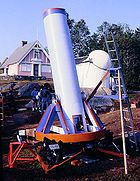
Telescope
A telescope is an instrument that aids in the observation of remote objects by collecting electromagnetic radiation . The first known practical telescopes were invented in the Netherlands at the beginning of the 1600s , using glass lenses...
s as a hobby
Hobby
A hobby is a regular activity or interest that is undertaken for pleasure, typically done during one's leisure time.- Etymology :A hobby horse is a wooden or wickerwork toy made to be ridden just like a real horse...
, as opposed to being a paid professional. Amateur telescope makers (sometimes called ATMs) build their instruments for personal enjoyment of a technical challenge, as a way to obtain an inexpensive or personally customized telescope, or as a research tool in the field of astronomy
Astronomy
Astronomy is a natural science that deals with the study of celestial objects and phenomena that originate outside the atmosphere of Earth...
. Amateur telescope makers are usually a sub-group in the field of amateur astronomy
Amateur astronomy
Amateur astronomy, also called backyard astronomy and stargazing, is a hobby whose participants enjoy watching the night sky , and the plethora of objects found in it, mainly with portable telescopes and binoculars...
.
Beginnings
Ever since Galileo took a Dutch invention and adapted it to astronomical use, astronomical telescope making has been an evolving discipline. Many astronomers after the time of Galileo built their own telescopes out of necessity, but the advent of amateurs in the field building telescopes for their own enjoyment and education seems to have come into prominence in the 20th century.Before the advent of modern mass produced telescopes the price of even a modest instrument was often beyond the means of an aspiring amateur astronomer. Building your own was the only economical method to obtain a suitable telescope for observing. There were many published works that helped spark an interest in building telescopes such as Irish telescope maker Rev. W. F. A. Ellison's 1920 book "The Amateur's Telescope".
In the United States
United States
The United States of America is a federal constitutional republic comprising fifty states and a federal district...
in the early 1920s articles in Popular Astronomy
Popular Astronomy (US magazine)
Popular Astronomy was a magazine for amateur astronomers published between 1893 and 1951. It was the successor to The Sidereal Messenger, which ceased publication in 1892. Each yearly volume of Popular Astronomy contained 10 issues, for a total of 59 volumes.The first editor, from 1893-1911, was...
by Russell W. Porter
Russell W. Porter
Russell Williams Porter was an American artist, engineer, amateur astronomer and explorer. He was a pioneer in the field of “cutaway illustration" and is sometimes referred to as the "founder" or one of the "founders" of amateur telescope making."-Biography:Russell W...
and in Scientific American
Scientific American
Scientific American is a popular science magazine. It is notable for its long history of presenting science monthly to an educated but not necessarily scientific public, through its careful attention to the clarity of its text as well as the quality of its specially commissioned color graphics...
by Albert G. Ingalls
Albert Graham Ingalls
Albert Graham Ingalls was an American scientific editor and amateur astronomer. Through his columns in Scientific American, including "The Amateur Scientist", and his three-volume series Amateur Telescope Making, Ingalls exerted a great influence on amateur astronomy and amateur telescope making...
featuring Porter and the Springfield Telescope Makers helped expand interest in the hobby. There was so much public interest Ingalls began a regular column for Scientific American on the subject (spawning that publications The Amateur Scientist
The Amateur Scientist
The Amateur Scientist was a column in the Scientific American, and was the definitive "how-to" resource for citizen-scientists for over 72 years , making it the longest running column in Scientific American's history...
column) and later compiled into three books titled Amateur Telescope Making
Amateur Telescope Making
Amateur Telescope Making is a series of three books edited by Albert G. Ingalls between 1926 and 1953 while he was an associate editor at Scientific American. The books cover various aspects of telescope construction and observational technique, sometimes at quite an advanced level, but always in...
Vol. 1-3. These had a large readership of enthusiast (sometimes called "telescope nuts") constructing their own instruments. Between 1933 and 1990, Sky and Telescope magazine ran a regular column called "Gleanings for ATMs" edited by Earle Brown, Robert E. Cox
Robert E. Cox
-Career:Cox worked briefly at Perkin Elmer in 1939. Shortly thereafter he was inducted into the Army Air Corps and served for two years in the South Pacific as a weather specialist. After the war, Cox accepted part-time positions as photographic technician at Harvard Observatory and as staff...
& Roger Sinnott. The ready supply of surplus optical components after World War 2 and later Sputnik and the space race
Space Race
The Space Race was a mid-to-late 20th century competition between the Soviet Union and the United States for supremacy in space exploration. Between 1957 and 1975, Cold War rivalry between the two nations focused on attaining firsts in space exploration, which were seen as necessary for national...
also greatly expanded the hobby.
"The Poor Man's Telescope"
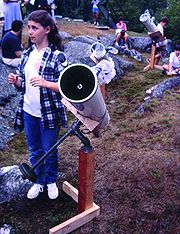
Refracting telescope
A refracting or refractor telescope is a type of optical telescope that uses a lens as its objective to form an image . The refracting telescope design was originally used in spy glasses and astronomical telescopes but is also used for long focus camera lenses...
, Schmidt Cassegrains and Maksutovs. The most popular telescope design is the Newtonian reflector
Newtonian telescope
The Newtonian telescope is a type of reflecting telescope invented by the British scientist Sir Isaac Newton , using a concave primary mirror and a flat diagonal secondary mirror. Newton’s first reflecting telescope was completed in 1668 and is the earliest known functional reflecting telescope...
, described by Russell W. Porter
Russell W. Porter
Russell Williams Porter was an American artist, engineer, amateur astronomer and explorer. He was a pioneer in the field of “cutaway illustration" and is sometimes referred to as the "founder" or one of the "founders" of amateur telescope making."-Biography:Russell W...
as “The Poor Man's Telescope”. The Newtonian has the advantage of being a simple design that allows for maximum size for the minimum expense. And since the design employs a single front surface mirror as its objective
Objective (optics)
In an optical instrument, the objective is the optical element that gathers light from the object being observed and focuses the light rays to produce a real image. Objectives can be single lenses or mirrors, or combinations of several optical elements. They are used in microscopes, telescopes,...
it means (for the person creating the optical elements) that there is only one surface that has to be ground and polished, as opposed to three for the Maksutov and four for the refractor
Refracting telescope
A refracting or refractor telescope is a type of optical telescope that uses a lens as its objective to form an image . The refracting telescope design was originally used in spy glasses and astronomical telescopes but is also used for long focus camera lenses...
and the Schmidt-Cassegrain. A properly designed and built Newtonian is a high performance instrument, fully capable of matching the performance of other designs, a case where inexpensive does not mean inferior. Typically a Newtonian telescope
Newtonian telescope
The Newtonian telescope is a type of reflecting telescope invented by the British scientist Sir Isaac Newton , using a concave primary mirror and a flat diagonal secondary mirror. Newton’s first reflecting telescope was completed in 1668 and is the earliest known functional reflecting telescope...
of 6” or 8" (15 or 20 cm) aperture
Aperture
In optics, an aperture is a hole or an opening through which light travels. More specifically, the aperture of an optical system is the opening that determines the cone angle of a bundle of rays that come to a focus in the image plane. The aperture determines how collimated the admitted rays are,...
is considered a good starter project. Some widely available plans found on the Internet include instructions for building 6", 8", and 10" Newtonians.
Mirror making
.jpg)
Newtonian telescope
The Newtonian telescope is a type of reflecting telescope invented by the British scientist Sir Isaac Newton , using a concave primary mirror and a flat diagonal secondary mirror. Newton’s first reflecting telescope was completed in 1668 and is the earliest known functional reflecting telescope...
is the most common telescope built by amateur telescope makers, large sections of the literature on the subject are devoted to fabrication of the primary mirror
Primary mirror
A primary mirror is the principal light-gathering surface of a reflecting telescope.-Description:The primary mirror of a reflecting telescope is a spherical or parabolic shaped disks of polished reflective metal , or in later telescopes, glass or other material coated with a reflective layer...
. The mirror has to be carefully ground
Abrasive machining
Abrasive machining is a machining process where material is removed from a workpiece using a multitude of small abrasive particles. Common examples include grinding, honing, and polishing...
, polished
Polishing
Polishing is the process of creating a smooth and shiny surface by rubbing it or using a chemical action, leaving a surface with a significant specular reflection In some materials polishing is also able to reduce diffuse reflection to...
and figured
Figuring
Figuring is the process of final polishing of an optical surface to remove imperfections or modify the surface curvature to achieve the shape required for a given application.-Types of figuring:...
to an extremely accurate shape, usually a paraboloid
Parabola
In mathematics, the parabola is a conic section, the intersection of a right circular conical surface and a plane parallel to a generating straight line of that surface...
. Telescopes with high focal ratios may use spherical mirrors since the difference in the two shapes is insignificant at those ratios. The tools used to achieve this shape are surprisingly simple, consisting of a similarly sized glass tool, a series of finer abrasives, and a polishing pitch lap made from a type of tree sap. Through a whole series of random strokes the mirror naturally tends to become spherical in shape. At that point, a variation in polishing strokes is typically used to create and perfect the desired paraboloidal shape.
Foucault test
The equipment most amateurs use to test the shape of the mirrors, a Foucault knife-edge testFoucault knife-edge test
The Foucault knife-edge test was described in 1858 by French physicist Léon Foucault to measure conic shapes of optical mirrors, with error margins measurable in fractions of wavelengths of light . It is commonly used by amateur telescope makers for figuring small astronomical mirrors...
, is, like the tools used to create the surface, simple to fabricate. At its most basic it consists of a light bulb, a piece of tinfoil with a pinhole in it, and a razorblade.
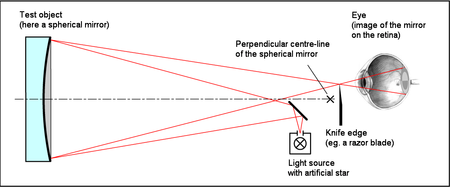
Some amateur telescope makers use a similar test called a Ronchi test
Ronchi test
In optical testing a Ronchi test is a method of determining the surface shape of a mirror used in telescopes and other optical devices.-Description:...
that replaces the knife edge with a grating comprising several fine parallel wires or an etching on a glass plate. Other tests used include the Gaviola or Caustic test which can measure mirrors of fast f/ratio more accurately, and home-brew Interferometric testing made possible in recent years by affordable lasers, digital cameras (such as webcams), and computers.
Aluminizing or "silvering" the mirror
Once the mirror surface has the correct shape a very thin coating of a highly reflective material is added to the front surface.Historically this coating was silver. Silvering
Silvering
Silvering is the chemical process of coating glass with a reflective substance. When glass mirrors first gained widespread usage in Europe during the 16th century, most were made of an amalgam of tin and mercury, but by the 19th century mirrors were commonly made through a process by which silver...
was put on the mirror chemically, typically by the mirror maker or user. Silver coatings have higher reflectivity than aluminum but corrode quickly and need replacing after a few months.
Since the 1950s most mirror makers have the coating applied by a thin-film deposition processes (work that has to be done by a firm specializing in the process). Originally the coatings were aluminum. Modern coatings usually contain aluminum and other compounds.
The mirror is aluminized by placing it in a vacuum chamber with electrically heated tungsten or nichrome coils that can evaporate
Evaporation (deposition)
Evaporation is a common method of thin film deposition. The source material is evaporated in a vacuum. The vacuum allows vapor particles to travel directly to the target object , where they condense back to a solid state...
aluminum. In a vacuum, the hot aluminum atoms travel in straight lines. When they hit the surface of the mirror, they cool and stick. Some mirror coating shops then evaporate a layer of quartz onto the mirror, whereas others expose it to pure oxygen or air in an oven so that the mirror will form a tough, clear layer of aluminum oxide.
Telescope design
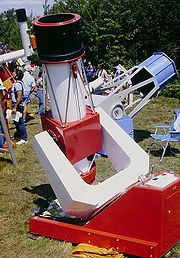
Astronomy
Astronomy is a natural science that deals with the study of celestial objects and phenomena that originate outside the atmosphere of Earth...
. Instruments built by amateurs have been employed in planetary study, astrometry
Astrometry
Astrometry is the branch of astronomy that involves precise measurements of the positions and movements of stars and other celestial bodies. The information obtained by astrometric measurements provides information on the kinematics and physical origin of our Solar System and our Galaxy, the Milky...
, photometry
Photometry (astronomy)
Photometry is a technique of astronomy concerned with measuring the flux, or intensity of an astronomical object's electromagnetic radiation...
, comet and asteroid discovery to name just a few. Even the “hobbyist” end of the field can break down into several distinct categories such as: observing deep sky
Deep sky
Deep-sky objects are astronomical objects other than individual stars and solar system objects . The classification is used for the most part by amateur astronomers to denote visually observed faint naked eye and telescopic objects such as star clusters, nebulae and galaxies.-Origins and...
objects, observing the planets, solar observing, lunar observation, and astrophotography
Astrophotography
Astrophotography is a specialized type of photography that entails recording images of astronomical objects and large areas of the night sky. The first photographs of an astronomical object were taken in the 1840s, but it was not until the late 19th century that advances in technology allowed for...
of all those class of objects. Therefore the design, size, and construction of the telescopes vary as well. Some amateur telescope makers build instruments that, while looking crude, are wholly suited to the purpose they are designed for. Others may strive for a more aesthetic look with high levels of mechanical “finish”. Since some amateur telescope makers do not have access to high-precision machining equipment, many elegant designs such as the Poncet Platform
Poncet Platform
A Poncet Platform or Poncet mount is a type of equatorial platform that uses a simple polar pivot and an inclined plane. The motion of the mount allows any device sitting on that platform to track the apparent motion of the stars in the night sky...
, Crayford focuser
Crayford focuser
The Crayford focuser is a simplified focusing mechanism for amateur astronomical telescopes. The design replaces the complicated rack and pinion drive normally found in this type of device with a smooth spring-loaded shaft which holds the focus tube against four opposing bearing surfaces...
, and the Dobsonian telescope
Dobsonian telescope
A Dobsonian telescope is an alt-azimuth mounted newtonian telescope design popularized by the amateur astronomer John Dobson starting in the 1960s. Dobson's telescopes featured a simplified mechanical design that was easy to manufacture from readily available components to create a large, portable,...
have evolved, which achieve functionality and stability without requiring precision machining.
The difficulty of construction is another factor in an amateur’s choice of project. For a given design the difficulty of construction grows roughly as the square of the diameter of the objective. For example a Newtonian telescope of 4 inches (101.6 mm) aperture is a moderately easy science fair project. A 6 to 8 in (152.4 to 203.2 mm) Newtonian is considered a good compromise size since construction is not difficult and results in an instrument that would be expensive to purchase commercially. A 12 to 16 in (304.8 to 406.4 mm) reflecting telescope is difficult, but still within the ability of the average amateur who has had experience building smaller instruments. Amateurs have constructed telescopes as large as 1 metres (39.4 in) across, but usually small groups or astronomy clubs take on such projects.
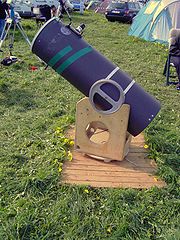
See also
- Amateur astronomyAmateur astronomyAmateur astronomy, also called backyard astronomy and stargazing, is a hobby whose participants enjoy watching the night sky , and the plethora of objects found in it, mainly with portable telescopes and binoculars...
- Group 70Group 70Group 70 is a non-profit educational organization of people from many countries all around the world and many walks of life seeking to make astronomy available to the peoples of the world....
— Attempt at making the world's largest amateur-built telescope - List of telescope parts and construction
- Mirror support cellMirror support cellIn astronomy the mirror support cell - more commonly mirror cell - is the component of a reflecting telescope which supports the mirror in place to hold optical alignment, allow collimation adjustment, and protect it from falling out...
- Optical telescopeOptical telescopeAn optical telescope is a telescope which is used to gather and focus light mainly from the visible part of the electromagnetic spectrum for directly viewing a magnified image for making a photograph, or collecting data through electronic image sensors....
- PLate OPtimizerPLate OPtimizerPLate OPtimizer, or PLOP is a CAD program used by amateur telescope makers to design primary mirror support cells for reflecting telescopes. It was developed by telescope maker David Lewis, first described in 1999, and used to simplify calculations needed in the design of mirror support cells...
- StellafaneStellafaneStellafane is the name of the clubhouse built by the Springfield Telescope Makers club of Springfield, Vermont in the early 1920s, and has since come to refer to the club's land and buildings on the summit of Breezy Hill...
Telescope making books and other published information
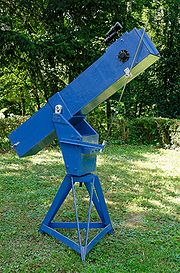
- Albert G. IngallsAlbert Graham IngallsAlbert Graham Ingalls was an American scientific editor and amateur astronomer. Through his columns in Scientific American, including "The Amateur Scientist", and his three-volume series Amateur Telescope Making, Ingalls exerted a great influence on amateur astronomy and amateur telescope making...
(ed.), Amateur Telescope MakingAmateur Telescope MakingAmateur Telescope Making is a series of three books edited by Albert G. Ingalls between 1926 and 1953 while he was an associate editor at Scientific American. The books cover various aspects of telescope construction and observational technique, sometimes at quite an advanced level, but always in...
(Vols. 1-3). Orig. edition: Scientific American; new rearranged edition: Willmann-Bell Inc. - Allyn J. Thompson, Making Your Own Telescope, 19471947 in literatureThe year 1947 in literature involved some significant events and new books.-Events:*The Diary of Anne Frank is published for the first time.*Jack Kerouac makes the journey which he will later chronicle in his book On the Road....
, Sky Publishing, ISBN 0-933346-12-3. (An online version) - Jean Texereau, How to Make a Telescope, Willmann-Bell, ISBN 0-943396-04-2
- David Harbour, Understanding Foucault, Netzari Press, ISBN 978-1-934916-01-8, (Amazon.com)
- David Kriege, Richard Berry, The Dobsonian Telescope: A Practical Manual for Building Large Aperture Telescopes, 1997, Willmann-Bell, ISBN 0-943396-55-7
- Richard Berry, Build Your Own Telescope, Willmann-Bell, ISBN 0-943396-69-7
- Harrie Rutten, Martin van Venrooij, Telescope Optics, Evaluation and Design, Willmann-Bell, ISBN 0-943396-18-2
- Neal Eltinge Howard, Standard Handbook for Telescope Making (Hardcover), Harper & Row, ISBN 978-0-06-181394-8
External links
- A Little Amateur History (R.F. Royce)
- A Manual for Amateur Telescope Makers by Karine and Jean-Marc Lecleire (PDF introduction)
- The Amateur Telescope Makers Email List — also has searchable archives
- The ATM Site - A Short History of Amateur Telescope Making
- The Telescope Makers of Springfield, Vermont History at stellafane.com.

